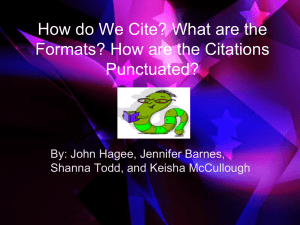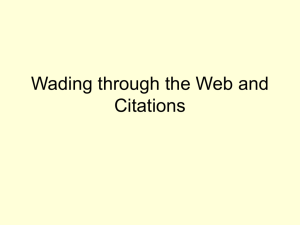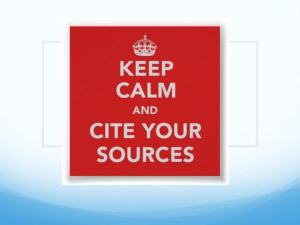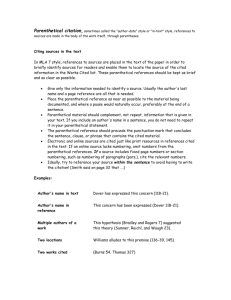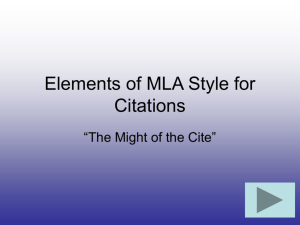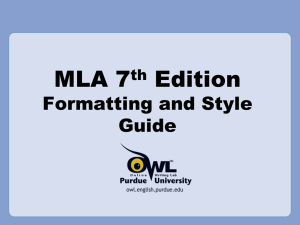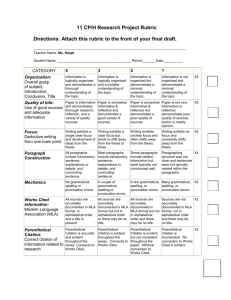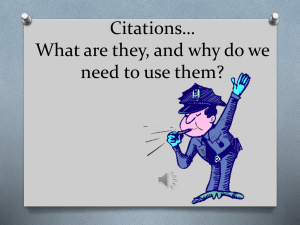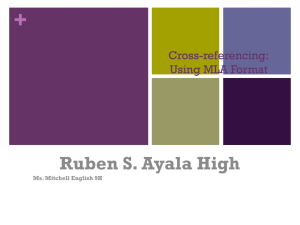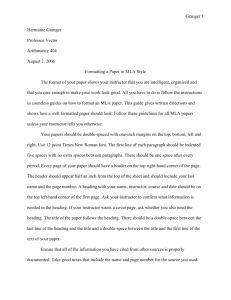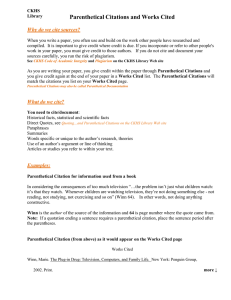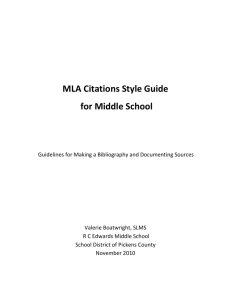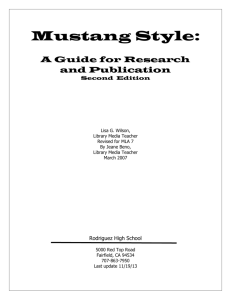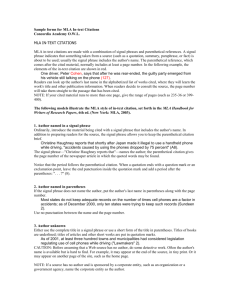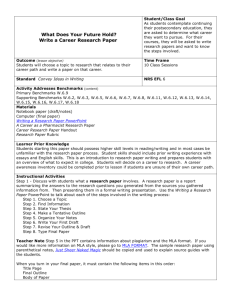Bill Smith
advertisement
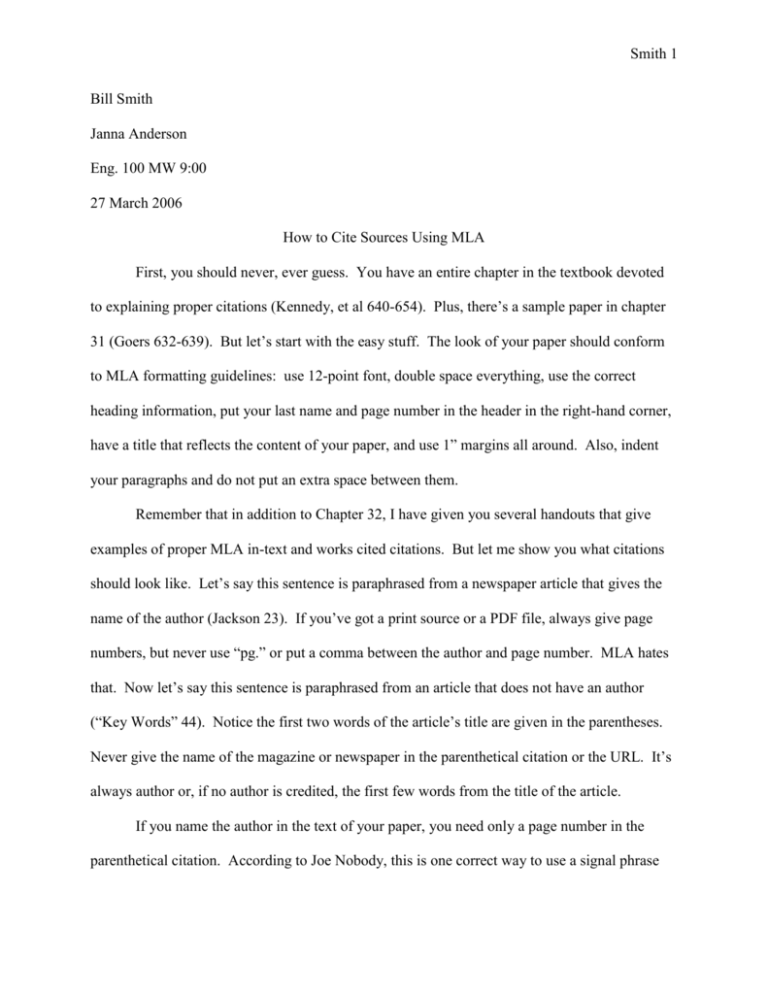
Smith 1 Bill Smith Janna Anderson Eng. 100 MW 9:00 27 March 2006 How to Cite Sources Using MLA First, you should never, ever guess. You have an entire chapter in the textbook devoted to explaining proper citations (Kennedy, et al 640-654). Plus, there’s a sample paper in chapter 31 (Goers 632-639). But let’s start with the easy stuff. The look of your paper should conform to MLA formatting guidelines: use 12-point font, double space everything, use the correct heading information, put your last name and page number in the header in the right-hand corner, have a title that reflects the content of your paper, and use 1” margins all around. Also, indent your paragraphs and do not put an extra space between them. Remember that in addition to Chapter 32, I have given you several handouts that give examples of proper MLA in-text and works cited citations. But let me show you what citations should look like. Let’s say this sentence is paraphrased from a newspaper article that gives the name of the author (Jackson 23). If you’ve got a print source or a PDF file, always give page numbers, but never use “pg.” or put a comma between the author and page number. MLA hates that. Now let’s say this sentence is paraphrased from an article that does not have an author (“Key Words” 44). Notice the first two words of the article’s title are given in the parentheses. Never give the name of the magazine or newspaper in the parenthetical citation or the URL. It’s always author or, if no author is credited, the first few words from the title of the article. If you name the author in the text of your paper, you need only a page number in the parenthetical citation. According to Joe Nobody, this is one correct way to use a signal phrase Smith 2 and citation (77). But Sue Somebody writes in her online posting that parenthetical citations aren’t needed if there is no page number and you’ve given the author’s name in a signal phrase. In fact, if you’re going to quote an article directly, “try to use a signal phrase or paraphrase most of the sentence” (Hagan). Also remember that online sources can be sketchy (“Some Stuff”). If someone was quoted in an article, and you’d like to use that same quotation, acknowledge the person who said it in the text of your paper, and acknowledge the article’s author in the parenthetical citation. For instance, Jack Collins said, “I love MLA!” (qtd. in Mayberry 25). If for some reason you really, really need to quote a very long passage, use block format, like this: This passage came directly from the source and is being put into your paper wordfor-word. You decided to quote rather than paraphrase because the wording was so dazzling or moving that the information would lose its power if you changed it. Remember to indent block quotations ten spaces, not five, and don’t use quotation marks. And for some odd reason, this is the only time MLA wants you to put the period BEFORE the parenthetical citation. Don’t ask me why. (Anderson) Additionally, after you use a source, try to spend some time examining the relevance of the information. Tie it to your thesis. If you have any questions about proper use of sources, email me, come to my office, go to the Writing Center, or look in your text book or online. The next page of this document will be the works cited page, which is ALWAYS titled Works Cited after the paper is written. It is always the last page of your paper and should contain your last name and page number in the right-hand corner. I’ve put examples of EXACTLY how the most commonly used sources are cited. The information, however, is mostly fictitious. Alphabetize, use hanging indentation, and do not number the entries. Give original publication information and secondary information for database and textbook articles. Smith 3 Works Cited Anderson, Janna. “MLA is Fun.” Journal of Fun Stuff 56.4 (2006): 55-60. eLibrary. Proquest Information and Learning. Fullerton College Lib. Fullerton, CA. 27 March 2006 <http://www.bigchalk.com> Goers, Sarah E. “Is Inclusion the Answer?” In The Bedford Guide for College Writers, 7th ed. Eds. X. J. Kennedy, et al. Boston: Bedford/St. Martin’s, 2005. 632-639. Hagan, Will. “Follow This Format for Website Articles.” LATimes.com 1 Sept. 2005. 27 March 2006. <http://www.latimes.com/lotsofstuff/weirdsymbols_includeitall> Jackson, Joyce. “I’m an Article Originally Published in a Magazine and Reprinted in Our Textbook.” Time Feb. 2001. Rpt. in The Bedford Guide for College Writers, 7th ed. Eds. X. J. Kennedy, et al. Boston: Bedford/St. Martin’s, 2005. 899-902. Kennedy, X. J., et all. The Bedford Guide for College Writers, 7th ed. Boston: Bedford/St. Martin’s, 2005. “Key Words Can Be Interesting.” Editorial. USA Today 3 March 2006: 44. Mayberry, Laura. “My Article is a Printable PDF File from a Database.” Interesting Newsletter 4 Sept. 2001: 21-26. MasterFile Premier. Ebsco. Fullerton College Lib. Fullerton, CA 27 March 2006 <http://www.search.epnet.com>. Nobody, Joe. “This is a Specialized Magazine, Not a Professional Journal.” Research Paper Hobbiest Nov. 2004: 75-81. “Some Stuff You Find Online Might Not Be Reliable.” Site With No Authors or Dates. 27 March 2006. <www.theunreliablesource.net/whywouldyouusethis/donottrustit> Somebody, Sue. “Are You Sure This One is Reliable?” The Anti-Website May 2005. 27 March 2006. <http://www.noweb.com/articles/opinions/someotherstuff>. Smith 4 THIS ARTICLE’S SOURCE IS: http://staffwww.fullcoll.edu/janderson/100%20stuff/handouts.htm
